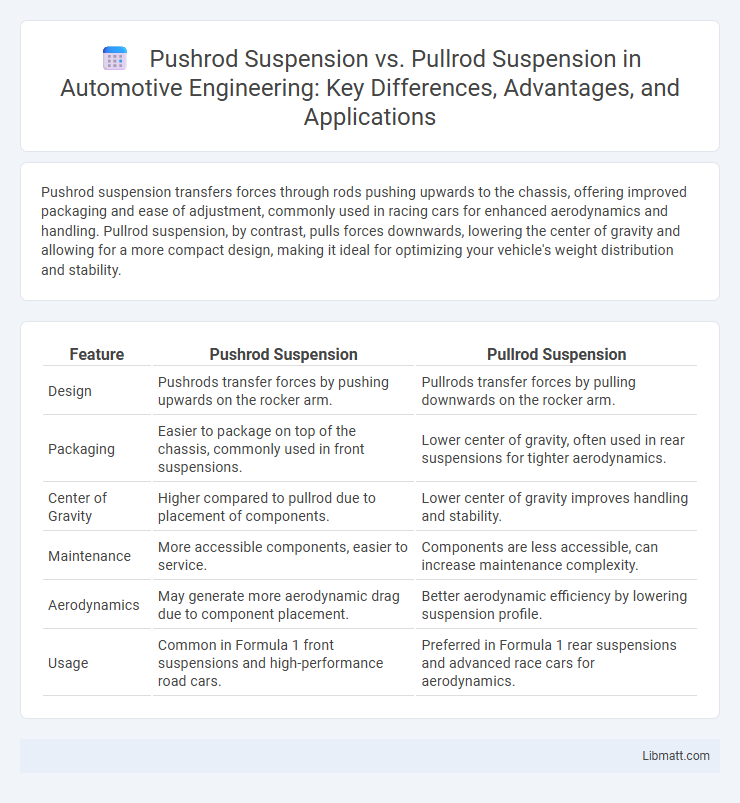Pushrod suspension transfers forces through rods pushing upwards to the chassis, offering improved packaging and ease of adjustment, commonly used in racing cars for enhanced aerodynamics and handling. Pullrod suspension, by contrast, pulls forces downwards, lowering the center of gravity and allowing for a more compact design, making it ideal for optimizing your vehicle's weight distribution and stability.
Table of Comparison
| Feature | Pushrod Suspension | Pullrod Suspension |
|---|---|---|
| Design | Pushrods transfer forces by pushing upwards on the rocker arm. | Pullrods transfer forces by pulling downwards on the rocker arm. |
| Packaging | Easier to package on top of the chassis, commonly used in front suspensions. | Lower center of gravity, often used in rear suspensions for tighter aerodynamics. |
| Center of Gravity | Higher compared to pullrod due to placement of components. | Lower center of gravity improves handling and stability. |
| Maintenance | More accessible components, easier to service. | Components are less accessible, can increase maintenance complexity. |
| Aerodynamics | May generate more aerodynamic drag due to component placement. | Better aerodynamic efficiency by lowering suspension profile. |
| Usage | Common in Formula 1 front suspensions and high-performance road cars. | Preferred in Formula 1 rear suspensions and advanced race cars for aerodynamics. |
Introduction to Suspension Systems
Pushrod suspension systems transfer forces from the wheel to the chassis through pushrods connected to rockers and dampers, optimizing weight distribution and allowing for lower center of gravity in high-performance vehicles. Pullrod suspension operates by pulling the rod upward, offering aerodynamic advantages by lowering the mass and components within the chassis structure. Both systems are critical in motorsport engineering, enabling precise control of wheel movement and enhancing overall vehicle handling and stability.
What is Pushrod Suspension?
Pushrod suspension is a type of automotive suspension system where the wheel movement is transmitted via a pushrod to an inboard-mounted spring and damper setup, enhancing aerodynamic efficiency by reducing unsprung mass. Commonly used in high-performance and Formula 1 cars, pushrod designs allow for precise handling and improved suspension tuning by isolating suspension components within the chassis. This system optimizes weight distribution and suspension response, offering significant advantages in race car dynamics compared to traditional setups.
What is Pullrod Suspension?
Pullrod suspension is a type of automotive suspension system where the suspension components are activated by rods pulling on the rockers instead of pushing. This design allows for a lower center of gravity and improved aerodynamic efficiency in race cars by positioning suspension components closer to the chassis. Your choice between pullrod and pushrod suspension affects handling performance, weight distribution, and packaging within the vehicle chassis.
Key Structural Differences
Pushrod suspension features rods that transfer forces by pushing, connecting the wheel assembly to the chassis typically above the wheel, resulting in a more straightforward load path and easier access for adjustments. Pullrod suspension uses rods under tension that pull the suspension components upward, positioning the linkage lower and often allowing a lower center of gravity for improved handling. Understanding these key structural differences helps optimize Your vehicle's suspension design for performance, packaging, and aerodynamics.
Performance and Handling Characteristics
Pushrod suspension systems deliver superior handling by allowing precise tuning of spring and damper rates, resulting in enhanced front-end grip and improved aerodynamics due to lower unsprung mass. Pullrod suspension offers a lower center of gravity and more efficient packaging, which improves chassis stiffness and responsiveness under high-speed cornering. Both systems optimize load distribution and suspension geometry to maximize traction and stability, with pushrod favoring mechanical feedback and pullrod benefiting aerodynamic integration.
Applications in Motorsport
Pushrod suspension is commonly used in Formula 1 and endurance racing cars due to its ability to lower the car's center of gravity and improve aerodynamic efficiency by positioning components inside the chassis. Pullrod suspension is favored in certain Formula 1 teams and prototype racing cars for its advantage in packaging and weight distribution, allowing designers to lower the chassis height further. Your choice between pushrod and pullrod suspension in motorsport projects should consider the specific aerodynamic goals and mechanical design constraints of the vehicle.
Advantages of Pushrod Suspension
Pushrod suspension offers superior packaging flexibility, allowing for lower center of gravity and improved aerodynamics in high-performance vehicles. Its design enables easier access for maintenance and tuning, enhancing Your ability to optimize suspension settings quickly. The system also provides better load transfer and improved ride quality by isolating suspension components from road vibrations.
Advantages of Pullrod Suspension
Pullrod suspension systems offer improved aerodynamic efficiency by allowing lower and more compact packaging of suspension components, which reduces drag and enhances overall vehicle performance. They provide better center of gravity management due to the lower mounting position of the suspension elements, contributing to enhanced handling and stability in high-speed conditions. Maintenance accessibility is also optimized since the design places key components within easier reach, facilitating quicker adjustments and repairs compared to traditional pushrod setups.
Common Challenges and Limitations
Pushrod suspension systems commonly face challenges related to packaging constraints and increased complexity in routing the pushrod through the chassis, which can affect maintenance accessibility. Pullrod suspension designs often struggle with limited adjustability and higher susceptibility to damage due to their lower mounting positions and exposure to road debris. Both systems require careful tuning to balance stiffness and compliance, ensuring Your vehicle maintains optimal handling and ride quality under varying driving conditions.
Which Suspension Is Best for Your Needs?
Pushrod suspension offers superior ride comfort and easier maintenance, making it ideal for daily driving and road use. Pullrod suspension provides improved aerodynamics and better weight distribution, favored in high-performance and racing applications. Choosing between pushrod and pullrod suspension depends on whether you prioritize comfort and accessibility or performance and handling.
Pushrod suspension vs Pullrod suspension Infographic

 libmatt.com
libmatt.com